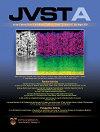Electron-enhanced atomic layer deposition of Ru thin films using Ru(DMBD)(CO)3 and effect of forming gas anneal
IF 2.1
3区 材料科学
Q3 MATERIALS SCIENCE, COATINGS & FILMS
引用次数: 0
Abstract
Ruthenium (Ru) thin films were deposited utilizing electron-enhanced atomic layer deposition (EE-ALD). Sequential exposures of Ru(DMBD)(CO)3 (DMBD = 2,3-dimethylbutadiene) and low-energy electrons at ∼125 eV were used to grow the Ru films at temperatures ≤160 °C. The electrons were obtained from a hollow cathode plasma electron source that provided an electron current of ∼200 mA over a surface area of ∼4 cm2. Low-energy electrons can desorb surface ligands derived from Ru(DMBD)(CO)3, such as CO, through electron-stimulated desorption. The desorbed surface ligands leave chemically reactive sites for subsequent Ru(DMBD)(CO)3 precursor absorption. Ru EE-ALD film growth was monitored utilizing in situ spectroscopic ellipsometry (SE). The electron exposures resulted in rapid Ru film nucleation and growth. Under saturation conditions at 160 °C, the growth rate for Ru EE-ALD was 0.2 Å/cycle. The electron efficiency factor for Ru EE-ALD was ∼21 500 electrons/deposited Ru atom. There was no film growth without electron exposures. Ru growth was observed on various substrates including silicon with native oxide and titanium. Ru growth was also obtained on insulating substrates such as 400 nm thick thermal SiO2 substrates. XPS analysis measured <1 at. % oxygen in the deposited Ru films. XRD, x-ray reflectivity, and SE were used to characterize the Ru films before and after forming gas anneal (FGA). FGA successfully removed carbon impurities from the as-deposited Ru films. The resistivity of the Ru EE-ALD films after FGA was determined to be as low as 17 μΩ cm for a film thickness of 6.7 nm. SE measurements of the imaginary part of the pseudodielectric function, 〈ɛ2〉, were utilized to characterize the as-deposited Ru films and the high purity Ru films after FGA. The low resistivity of the Ru films after FGA was consistent with a prominent Drude absorption in the ⟨ε2⟩ spectrum at ≤1 eV. Various reactive background gases such as H2, NH3, and H2O were utilized during EE-ALD to attempt to remove the carbon from the as-deposited Ru EE-ALD films.Ru(DMBD)(CO)3电子增强Ru薄膜原子层沉积及其形成气体退火的影响
采用电子增强原子层沉积技术(EE-ALD)制备钌薄膜。Ru(DMBD)(CO)3 (DMBD = 2,3-二甲基丁二烯)和低能电子在~ 125 eV下连续暴露,在≤160°C的温度下生长Ru薄膜。电子是从中空阴极等离子体电子源获得的,该电子源在约4 cm2的表面积上提供约200 mA的电子电流。低能电子通过电子刺激解吸,可以解吸Ru(DMBD)(CO)3衍生的表面配体,如CO。解吸的表面配体为随后的Ru(DMBD)(CO)3前体吸收留下了化学反应位点。利用原位光谱椭偏仪(SE)监测Ru EE-ALD薄膜的生长。电子暴露导致Ru膜快速成核和生长。在160℃饱和条件下,Ru EE-ALD的生长速率为0.2 Å/cycle。Ru EE-ALD的电子效率因子为~ 21 500个电子/沉积的Ru原子。没有电子曝光就没有薄膜生长。钌生长在不同的衬底上,包括天然氧化物硅和钛。在绝缘衬底(如400 nm厚的热SiO2衬底)上也可以得到Ru的生长。XPS分析测得<1 at。%氧在沉积的Ru膜。采用XRD、x射线反射率和SE对气体退火前后的Ru膜进行了表征。FGA成功地去除了沉积Ru膜中的碳杂质。当膜厚为6.7 nm时,经FGA处理后Ru EE-ALD薄膜的电阻率低至17 μΩ cm。利用赝介电函数虚部< 2 >的SE测量值来表征沉积的Ru膜和FGA后的高纯度Ru膜。FGA后Ru膜的低电阻率与≤1 eV时⟨ε2⟩谱中的显著Drude吸收一致。在EE-ALD过程中,利用各种反应性背景气体,如H2、NH3和H2O,试图从沉积的Ru EE-ALD膜中去除碳。
本文章由计算机程序翻译,如有差异,请以英文原文为准。
求助全文
约1分钟内获得全文
求助全文
来源期刊

Journal of Vacuum Science & Technology A
工程技术-材料科学:膜
CiteScore
5.10
自引率
10.30%
发文量
247
审稿时长
2.1 months
期刊介绍:
Journal of Vacuum Science & Technology A publishes reports of original research, letters, and review articles that focus on fundamental scientific understanding of interfaces, surfaces, plasmas and thin films and on using this understanding to advance the state-of-the-art in various technological applications.
 求助内容:
求助内容: 应助结果提醒方式:
应助结果提醒方式:


